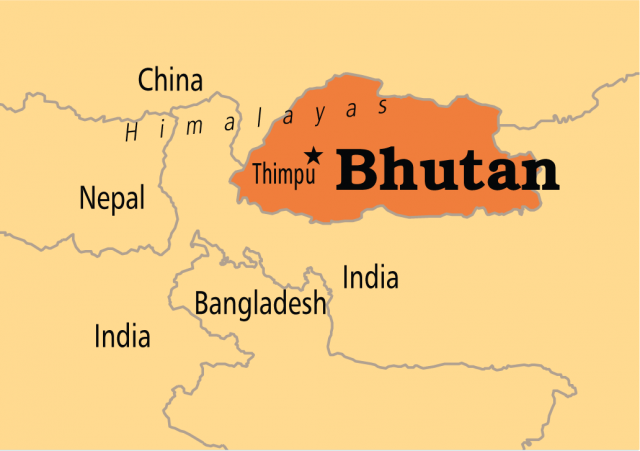Bhutan
Area 29,204 square mi (47,000 square km)
Population 765,600 2014
Capital Thimphu
Highest Point 24,780 ft (7,553 m)
Lowest Point 318 ft (97 m)
GDP $1.821 billion 2014
Primary Natural Resources hydropower.
BHUTAN IS A LANDLOCKED country located in the eastern part of the HIMALAYAN MOUNTAINS, bordered by INDIA in the south, east, and west and by TIBET in the north. At its lowest east-west corridor, Bhutan stretches around 186 mi (300 km), and it measures approximately 105 mi (170 km) at its north-south direction.
There are three main ethnic groups in Bhutan. The Ngalungs or Ngalops (often called Drukpas) live in the northwestern part of the country. They speak Dzonkha and are called Drukpas as they follow the Drukpa Kargyupa school of Tibetan Buddhism. The second ethnic group is called Sharchops and they inhabit the eastern and central region and practice Nyingmapa, a branch of Mahayana Buddhism. The Sharchops speak Tsangla, Kheng, Kurteop, Sharchopkha, and Brokpa dialects. The third major ethnic group is called Lhotshampas and they live in the southern foothills of Bhutan and speak primarily a Nepali language.

Bhutan is ruled by a hereditary monarch who governs the country with the support of a national assembly and the council of ministers. Bhutan does not have any written constitution. In 2001, the Bhutanese king commissioned the drafting of a constitution, which is to become effective in 2005. The royal government of Bhutan is guided by the aid and advice of the government of India in regard to its external relations. India is responsible for defense and foreign relations as per Article 2 of the Indo-Bhutan treaty.
Bhutan is primarily an agricultural country. The traditional form of agriculture is the main subsistence occupation for the majority of Bhutanese people, who involve themselves with agriculture, livestock, and related activities. The hydroelectricity power sector provides the single biggest revenue to Bhutan. India has been the prime market for Bhutan's finished products and imports. Bhutan imports from India necessary household items such as rice, vegetables, poultry, fish, wheat, and salt. Bhutan also imports other items such as petroleum products, automobiles, steel, sugar, medicines, and textile goods.
Bhutan has been identified as one of the 10 biodiversity hot spots in the world and as one of the 221 global bird areas. Its ecosystems harbor some of the most endangered species of the Himalayas, with an estimated 770 species of birds and over 50 species of rhododendron. They are enriched by a rich a wildlife with animals such as the snow leopard, golden langur, blue sheep, water buffalo, tiger, and elephant.